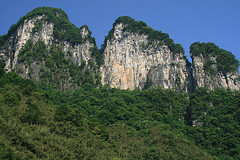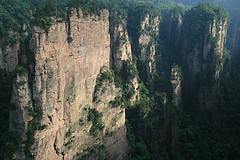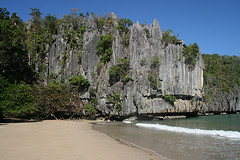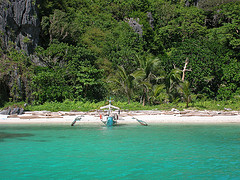Wowed in Hunan
Saturday, June 6th, 2009If I intimated in any way in my previous post that we were over karst scenery after seeing it so many times over the past 18 months, I apologise profusely and take it all back, every word. Because for the past four days, and past two in particular, we have been absolutely awestruck by the scenery in Hunan, and after six-and-a-half years of traveling around the world together, that doesn’t happen too often anymore.
Our travels in the province started ordinarily enough – the old commercial town of Hongjiang was actually a disappointment, and Fenghuang was a nice riverside town whose beauty was negated by the busloads of Chinese tourists, and accompanying music blaring from two riverside discos very close to our inn. At this point, we hadn’t had a proper blue sky day since leaving Lijiang more than two weeks earlier, and I was a little tired of China, which happens somewhat frequently (in the same way as India, but for different reasons).
 But then – as also invariably happens in India – we went to a place so lovely that it made me feel bad for ever wishing that I wasn’t in China: the village of Dehang, which is in a valley surrounded by gorgeous rice fields and beautiful limestone karsts. We spent two days walking on lovely stone trails through the fields, into little gorges, over stepping stone bridges and past waterfalls, with the karsts always looming above us. We hardly saw any other tourists – foreign or domestic – and had two glorious (and unexpected) blue-sky days to top it all off. Because of all these things, Dehang is sort of an anti-Yangshuo – the same dreamy scenery but yet infinitely more enjoyable. Sure, we certainly weren’t eating lasagna, but people weren’t calling us bamboo either (as in, the ‘Hello bamboo!’ cry that about 50 villagers say within five minutes when you’re near the bamboo rafts outside Yangshuo).
But then – as also invariably happens in India – we went to a place so lovely that it made me feel bad for ever wishing that I wasn’t in China: the village of Dehang, which is in a valley surrounded by gorgeous rice fields and beautiful limestone karsts. We spent two days walking on lovely stone trails through the fields, into little gorges, over stepping stone bridges and past waterfalls, with the karsts always looming above us. We hardly saw any other tourists – foreign or domestic – and had two glorious (and unexpected) blue-sky days to top it all off. Because of all these things, Dehang is sort of an anti-Yangshuo – the same dreamy scenery but yet infinitely more enjoyable. Sure, we certainly weren’t eating lasagna, but people weren’t calling us bamboo either (as in, the ‘Hello bamboo!’ cry that about 50 villagers say within five minutes when you’re near the bamboo rafts outside Yangshuo).
 As wonderful as Dehang was, however, it turned out to be just the entree. Our final stop in Hunan, in the northwest corner of the province, was the national park that’s called Wulingyuan but commonly referred to as Zhangjiajie. The park contains about 3000 karst upthrusts, the densest concentration anywhere in the world – think of the ‘Three Sisters’ in the Blue Mountains of Australia, and then imagine 3000 Sisters instead, and you’ll have some sort of an idea of what Zhangjiajie is like. We spent yesterday and today both hiking alongside the ‘Golden Whip’ stream and Shadao gully at ground level looking up at the karsts (many of which are over 300m high), and, best of all, looking down at them from viewpoints along the rim near the ‘First Bridge of the World’ and other interestingly named places such as ‘Cock-Pecking’. I don’t think I am exaggerating by saying that looking down 400 metres at this canyon, seeing nothing but lush green jungle and sandstone karsts for 270 degrees around you, is one of the world’s most spectacular natural sights. It joins the Karakorams and Himalayas as the most incredible such sight I’ve ever seen.
As wonderful as Dehang was, however, it turned out to be just the entree. Our final stop in Hunan, in the northwest corner of the province, was the national park that’s called Wulingyuan but commonly referred to as Zhangjiajie. The park contains about 3000 karst upthrusts, the densest concentration anywhere in the world – think of the ‘Three Sisters’ in the Blue Mountains of Australia, and then imagine 3000 Sisters instead, and you’ll have some sort of an idea of what Zhangjiajie is like. We spent yesterday and today both hiking alongside the ‘Golden Whip’ stream and Shadao gully at ground level looking up at the karsts (many of which are over 300m high), and, best of all, looking down at them from viewpoints along the rim near the ‘First Bridge of the World’ and other interestingly named places such as ‘Cock-Pecking’. I don’t think I am exaggerating by saying that looking down 400 metres at this canyon, seeing nothing but lush green jungle and sandstone karsts for 270 degrees around you, is one of the world’s most spectacular natural sights. It joins the Karakorams and Himalayas as the most incredible such sight I’ve ever seen.
Yet remarkably this place is virtually unknown to foreigners – we only saw three others in two days. Information about the park in English is hard to come by (we wonder if the LP author even went inside the park, judging by the writeup), though we may rewrite the Wikitravel section on Zhangjiajie to counter that. Of course, the Chinese are there in hordes and try to ruin it in their usual ways – with the microphones and even megaphones of the dozens of tour groups unnecessarily amplifying an already loud language, with their need to rent colourful traditional costumes and take photos of themselves even on a hiking trail, to have non-minority girls dressed up in said costumes giving them a singing and dancing ‘culture show’ even overlooking the canyon, to play harmonicas at the viewpoints etc. It all serves to spoil the serenity (which doesn’t seem to bother the Chinese, for whom seeing mind-blowing natural scenery is by itself not enough and must be supplemented with gimmicks, preferably involving culture shows), but fortunately Zhangjiajie is so spectacular that it rises above this stuff and still offers a fantastic experience.
Tired but extremely satisfied, we’re now at the end of our little Guangxi-Hunan trip. We fly to Hong Kong tomorrow to get new Chinese visas for one final work period in Guangzhou, and further travel after that to Xinjiang and beyond.
Finally, after blocking Flickr for several days last week to coincide with the 20th anniversary of the Tian’anmen Square massacare, so that the Chinese (who largely don’t know what happened in June 1989) wouldn’t stumble across any photos that may allow them to put all the pieces together, the Communist Party has now unblocked it. So, photos of Zhangjiajie and Dehang are here.


